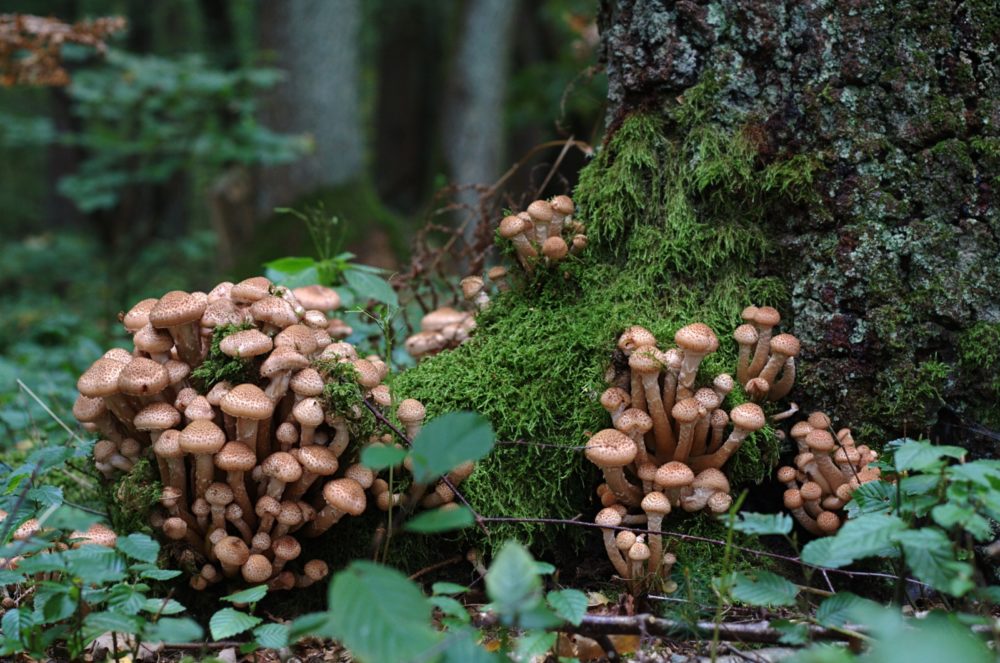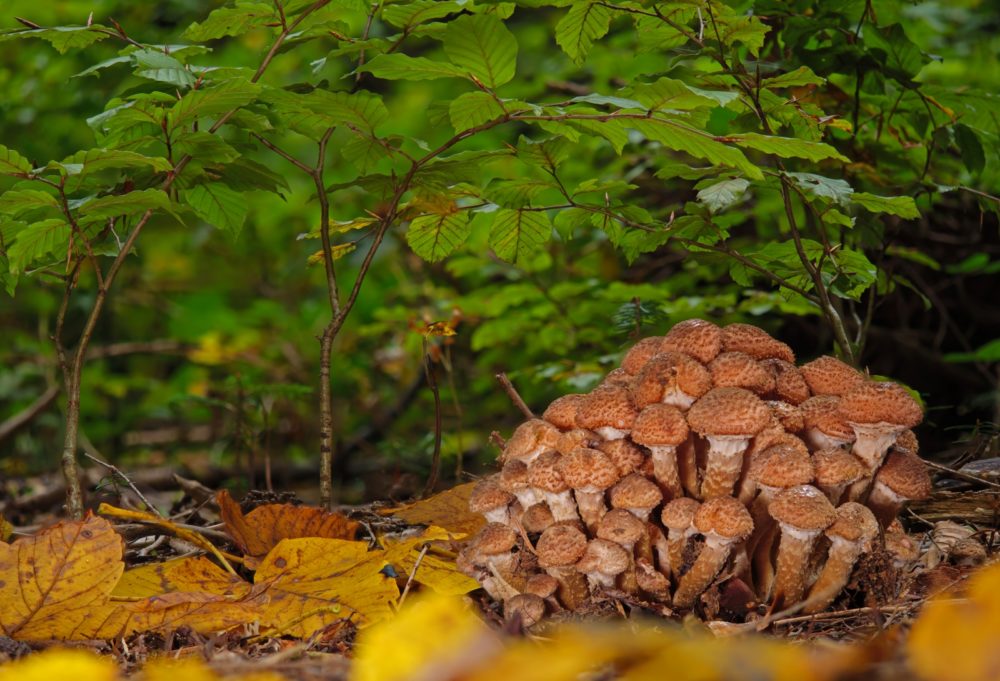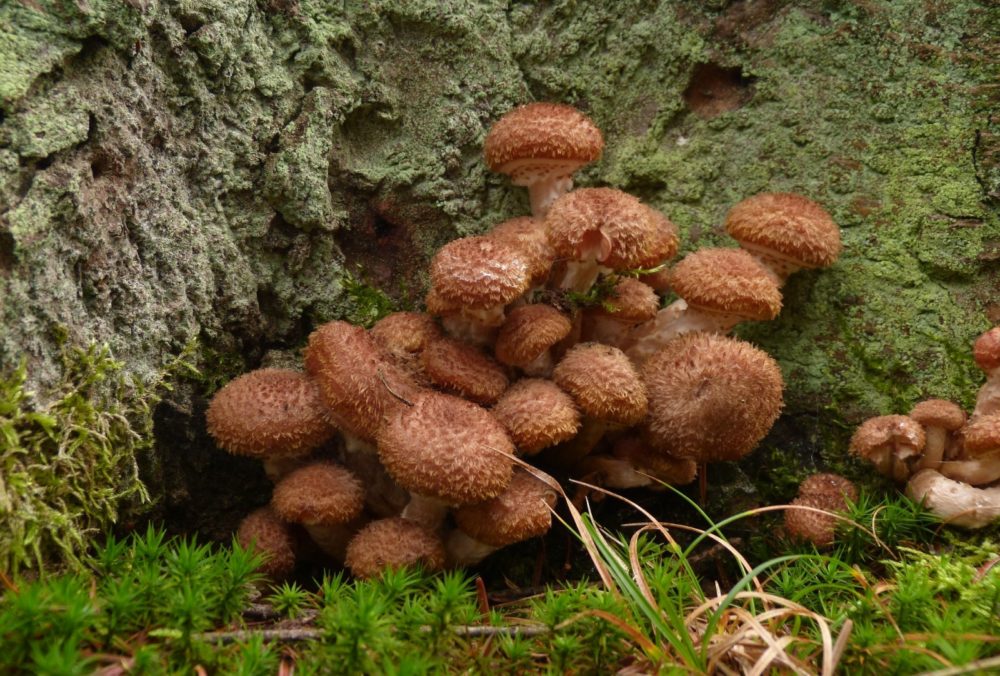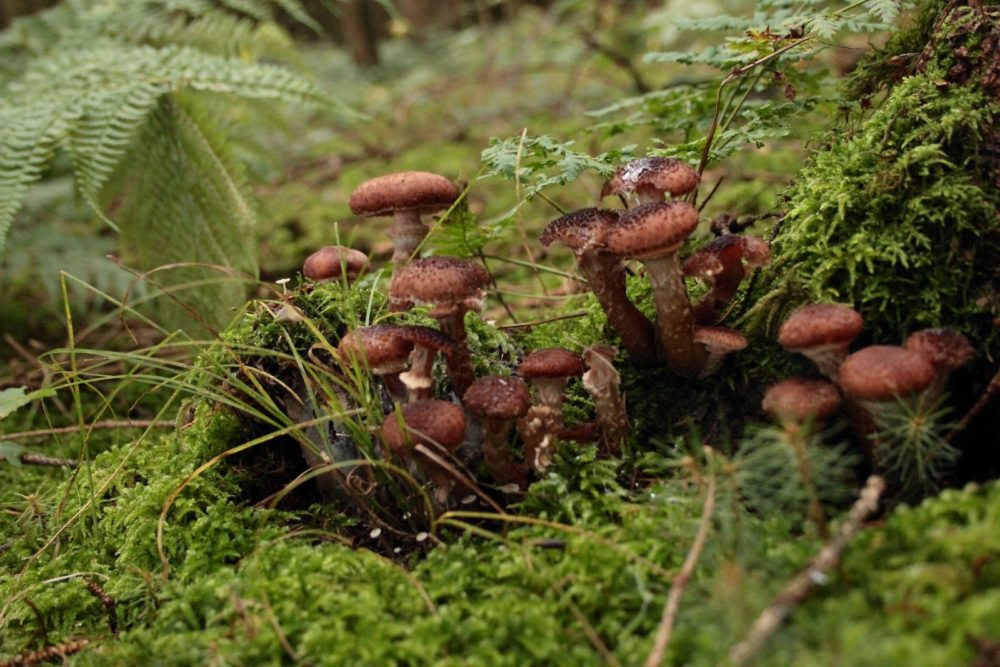Will mycorrhizae protect Norway spruce seedlings from attack by honey fungus?
 Honey fungus mushrooms belong among the most important pathogens of European forests. Trees stressed by high temperatures, soil dryness and mycorrhizal die-off are more sensitive to being attacked by honey fungus. The monocultures are the most endangered, especially non-native spruce stands on sites with compacted and acidic soil with a lack of nutrients.
Honey fungus mushrooms belong among the most important pathogens of European forests. Trees stressed by high temperatures, soil dryness and mycorrhizal die-off are more sensitive to being attacked by honey fungus. The monocultures are the most endangered, especially non-native spruce stands on sites with compacted and acidic soil with a lack of nutrients.
Infestation of tree species by honey fungus manifests itself by the oozing of resin, white wood rot, usually in the roots and the lower part of the stem, a bottle-like thickened base of the stems, a light gray-green to yellow-green coloration of the needles and later by the fall of the needles. It is possible to see the presence of fruiting bodies near the infested trees, with both the presence of whitish membranous syrrocium under the bark and the presence brown to black rope-like rhizomorphs on and around the roots.
In Europe, there are seven species of honey fungus: spruce, bulbous, tuberous, common, Nordic, swamp and ring less. The most important pathogen of spruce is the pine knot horn moth, followed by the bulbous moth.
A long-term measure against honey fungus, it is the change of spruce monocultures in forests close to nature. A higher representation of deciduous trees leads to an improvement of the soil, and thus to less favorable conditions for the development of honey fungus.
 Removing stumps with their roots suppresses the development of root rot caused by honey fungus and other pathogens and it leads to the development of communities of ectomycorrhizal fungi.
Removing stumps with their roots suppresses the development of root rot caused by honey fungus and other pathogens and it leads to the development of communities of ectomycorrhizal fungi.
On the contrary, thinning in areas with a strong infection pressure of honey fungus proves to be ineffective.
Antagonistic organisms, especially fungi of the genus Trichoderma, can also be used to suppress the honey fungus.
Artificial inoculation with mycorrhizal fungi (hereinafter referred to as “inoculation”) represents a method to support plant growth, using the principle of mycorrhizal symbiosis – mutually beneficial coexistence of plant and fungal organisms.
Scientists from FGMRI (VÚLHM, v. v. i.), focused on this issue, and they investigated how inoculation affects the attractiveness, growth and resistance of Norway spruce seedlings against the infection pressure of honey fungus. Based on the results and comparison with previous studies, they assessed the short-term and long-term effectiveness of inoculation.
They published their results in the article Influence of mycorrhizal preparation and fertilizer on growth and honey fungus infestation of Norway spruce (Vliv mykorhizního přípravku a hnojiva na růst a napadení sazenic smrku ztepilého václavkami), which was published in the Reports of Forestry Research 2/2023.
 Regarding the ongoing climate change, characterized by changes in the average values of climate factors and increasingly extreme weather fluctuations, including longer periods of drought, it can be expected that inoculation will be an increasingly important way of supporting seedlings when growing them in nurseries and when establishing and restoring forest stands.
Regarding the ongoing climate change, characterized by changes in the average values of climate factors and increasingly extreme weather fluctuations, including longer periods of drought, it can be expected that inoculation will be an increasingly important way of supporting seedlings when growing them in nurseries and when establishing and restoring forest stands.
For successful inoculation, it is necessary that the used mycorrhizal fungi are able to easily and quickly form mycorrhizae with the host plant, are adapted to the habitat conditions and resistant to stress.
Inoculation has a positive effect on survival rate, plant growth and leads to an increase in resistance to various abiotic influences and biotic harmful agents. Inoculation has also been shown to increase the abundance of mycorrhizal fungi, which is important in the establishment of forest stands.
The positive influence of inoculation to forest species, it is particularly pronounced in adverse conditions.
Nevertheless, the effect of inoculation on the survival rate, growth of seedlings and the ability to resist the infection pressure of the honey fungus may not be manifested and it may change significantly over time.
 An important role is played by the strength of the infection pressure of the honey fungus, the gradual reduction of the effect of inoculation due to the colonization of naturally occurring mycorrhizal fungi on the site, and the negative effect of fertilizers and fungicides on ectomycorrhizal fungi.
An important role is played by the strength of the infection pressure of the honey fungus, the gradual reduction of the effect of inoculation due to the colonization of naturally occurring mycorrhizal fungi on the site, and the negative effect of fertilizers and fungicides on ectomycorrhizal fungi.
At the conclusion of the study, the researchers pointed to the fact that Norway spruce seedlings were similarly attacked by the honey fungus three and a half years after inoculation, as well as non-inoculated seedlings. There was therefore an erasure of the differences compared to the period of one and a half years after inoculation, when only non-inoculated spruce seedlings were attacked.
The paper Influence of mycorrhizal preparation and fertilizer on growth and honey fungus infestation of Norway spruce (Vliv mykorhizního přípravku a hnojiva na růst a napadení sazenic smrku ztepilého václavkami) can be downloaded here.
Authors of paper: František Lorenc, Jan Lubojacký, FGMRI (VÚLHM, v. v. i.), Tomáš Tonka, University of South Bohemia in České Budějovice (Jihočeská univerzita v Českých Budějovicích); e-mail: lorenc@vulhm.cz
Prepared by: Ing. Jan Řezáč, VÚLHM, v. v. i., e-mail: rezac@vulhm.cz
Illustrative photo: Honey fungus in the forest
